It all starts with the hips. At the snap of the ball, the motion that is used to dictate movement on the field begins with the flexion or extension of the hips. If you look at the motion and break it down, what happens? The ball is snapped, and everyone begins to push off of the ground in an effort to move forward. Thamstrings begin to flex with the glutes, to extend the hips in a synergistic fashion which brings the legs backward, one after another. And in the same respect the hips flex as soon as the leg is ready to be brought forward so the body is in a position to gain ground. When you block a guy, coaches yell, "drop your butt and use your hips."
The same goes when you go to make a tackle. You want to get low and drive your hips through the man. Now look at the hamstring; it is know as a bi-articular muscle. That is, it crosses two joints: the hip and the knee. So when you think of hamstring training you typically do lots of leg curls. Which if you really want a great butt kick, seems like the right thing to do. But when you train your hips for power your hamstrings have another action as hip extensors. For this they recruit the help of the glute and the spinae erector muscle. Which is typically referred to within the context of your posterior chain.
What Is Responsible For Explosive Power On The Field?
That whole big area from your mid back to the back of your knee is responsible for the most important and explosive power on the field, the hips. You now begin to see that training your body to explode up and out becomes a matter of how strong your posterior chain is and how fast you can recruit those muscles to help propel you forward.
Before I get started, the first and most important aspect that needs to be addressed is the need for flexibility. More importantly, increasing your range of motion in your hips. If you are too tight in your hips you cannot make that important cut or get into a power position to make that open field tackle. Every movement on that field that you try to make will be inhibited and eventually lead to failure.
Along the same lines of being stiff you are not going to be able to make the gains in the weight room to enhance your play on the field without possessing a great range of motion in the hips. And since almost all explosive movement is centered on how much power you can muster from the hips you had better begin by being able to move them.
The Different Types Of Stretching!
When you examine the different types of stretching you come to find that there are different types, dynamic and static.
Dynamic Stretching
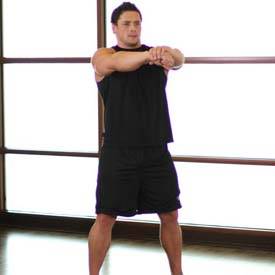
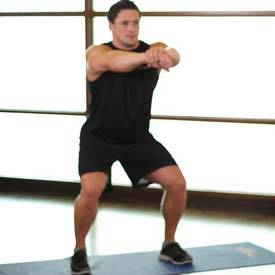
Sit Squats
Dynamic stretching comes in the form of a movements that we can use to enhance sport-specific functions. Within our dynamic work we will use many different methods often utilizing hurdles to promote the loosening of the hip joint.
Ducking under the hurdles and walking over in a highly diverse pattern of movements will assist in loosening the extensors the rectus femoris, sartorius, tensor fascia latae, along with the hip adductor and abductor muscles.
These muscles are all used to facilitate hip movement and are notorious for tightening up, causing cramps and of course lessening your ROM. The next type of stretch that we use is called a static stretch. In this type of stretch our main goal is to prevent injuries.
Static Streching
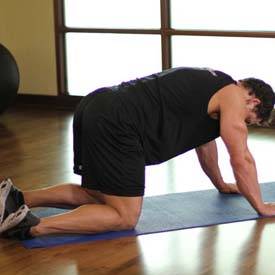
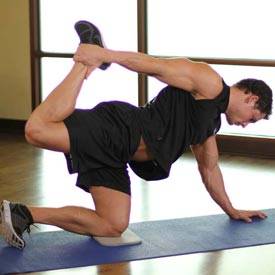
All Fours Quad Stretch
Stretches that require no movement are in essence static-you don't move. Both types of stretching (dynamic and static) help give the athlete the most basic of advantages when it comes to building a machine. So remember to keep on top of doing your stretches - it only makes you better.
Without these exercises the athlete is never loose enough to get the full benefit of the Olympic lifts and hybrids that are used. What's more is that athletes simply cannot move efficiently on the field because they lack the flexibility.
Posterior Chain
The next area of concern when looking at building explosive hip power is what kind of shape your posterior chain is in. If you look at all of the lifts that we do to build explosive strength and power in the hips, the backbone of that foundation is found throughout the posterior chain, which like I said before begins at about the mid back and extends down to the back of the knee.
Incorporating Kettlebell Swings Into Your Routine!
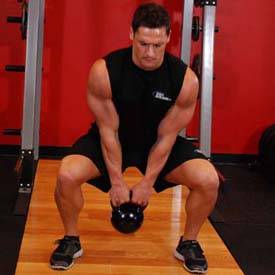
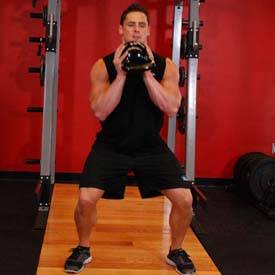
Open Palm Kettlebell Clean Images
I like to think of that entire area not as individual muscles that need to be worked by specific exercises, but as one solid chain to which every muscle fiber is acting together to reach an end result. Therefore, we should utilize exercises that incorporate the entire range of motion for those muscles. Kettlebell swings can be used to begin the foundation of that chain.
Swings are done through the legs and in an exploding fashion. Typically when this type of motion is attempted, the athlete merely tries to stand upright. The real emphasis is the explosion of the hips. You need to thrust the hips forward (not just stand up) something I believe seems to be a misconception in training the hips. Every movement needs to simulate that explosion forward or you are not attacking and using the exercise to its fullest potential.
Although swings are used almost every day, the idea that we are over training is crazy. The main reason for doing them is to build up your work threshold. Without this you are trying to ask your body to progress at an alarming rate, yet with no solid foundation holding it up. As your lifts progress in weight you set yourself up for injury. One area gets stronger than another by simply not exercising each area equally and pretty soon you have an imbalance in that chain, which like I said is a dangerous thing to have. So we do the swings to keep a constant base as you focus on more sport specific exercises.
Not only do they help work the entire posterior chain, but I believe the use of them also helps to facilitate recovery in that area, the same way that doing the work on the non-leg days helps to send blood flow into that area which in turn speeds up recovery.
Also remember, we do not want anyone worn out by the time they get to the actual lifts so the swings that we do are used at a weight that is sub-maximal. We intend to build this work up slowly; the lifts are what we try to get strong at. It is just work that needs to be taken care of before you perform the specific lifts. Get these done and you can move on to getting bigger stronger and faster. Don't do them and you will eventually fail.
Conclusion
So far I have shown you one exercise that is the foundation to any program. Without it there is no athlete. In the weeks to come I am going to bring in exercises that we do which help build hip power and teach the players to explode in any movement. But until then, keep swinging.
